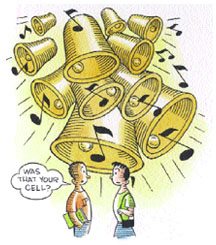To read our exclusively online On the Campus column, click here.


Summer bells, supper fun
By Kate Swearengen ’03
Illustration by Ron Barrett
Since June 22, Princeton residents within a half mile of Cleveland Tower and golfers on the nearby Springdale Golf Course have enjoyed the carillon concerts that take place at 1 p.m. every Sunday during the summer.
The crowd at the concerts usually numbers around 70. There are fewer when the weather is bad, but those who show up say the drizzle and the misty lawn give the Graduate College a medieval feel, an effect negated by the golfers who drive up in their carts.
Among the regulars is Scott Parry ’54, himself a carillonneur. When, as an undergraduate, he learned that Princeton had a bellmaster he went to the tower to watch him play and took up the instrument soon after. He spent another year at Princeton as a graduate student, and tried to convince university administrators to let him live in one of the upper chambers of the tower. His request was denied, but on warm nights he would take a sleeping bag up to the top of the tower anyway.
Parry is passionate about the carillon. One Sunday he offered to show it to me, but the wooden door leading to the bells was locked. Unfazed, Parry went at the bolt with the earpiece of his glasses. It broke off, and he tried the metal leg, this time with success.
Beyond the door were the 67 bells of Princeton’s carillon — one of the largest in the world. The heaviest bell weighs six tons, and is so big that six adults can stand underneath. “What happens if someone plays this bell while we’re under it?” I asked. “You’ll hear it.” Parry said.
A Thursday evening in August found professor of religion Cornel West *80 at the Annex, seated with a tall glass of ice water and a stack of books. West wore a dark suit, thick-framed glasses, and beautiful cufflinks. He was the most distinguished-looking person in the Annex that night, maybe all year.
West is one of the most accessible professors at Princeton. On campus, students who introduce themselves to him are greeted with a vigorous embrace and a “hello, sister” or “hello, brother.” In the Annex, students who invite him to sit at their tables are taken up on their offers.
This night West told us he had just returned from Liberia, and was heartbroken by the political situation, especially by its impact on children. He recalled having to pass through three tiers of armed guards to meet the various rebel leaders, and expressed misgivings about those who would replace president Charles Taylor. “Are they going to be gangsters, too?” West asked.
A somber mood passed over the table. West dispelled it with a simple question. “Athens? You’re from Greece? I guess you’re ahead of all of us. Columbia, Missouri? We’ve got Athens, Greece, and Columbia, Missouri? Now that’s diversity. That’s beautiful.” West said.
Has it been only two years since a bronze statue of John Witherspoon was unveiled on the lawn of East Pyne, to the strains of a bagpipe and the gentle applause of an appreciative crowd?
Now the statue, surrounded by a chain-link fence, stands mere feet away from a cluster of putty-colored portable toilets. It is flanked by a pile of gravel and by a yellow machine, a steamroller in miniature, that the construction workers laboring on the site refer to as the “whacker.” The space in front of the statue — in fact, the entire area bounded by Firestone Library, the Chapel, Cannon Green, and Murray-Dodge — has succumbed to the present Princetonian epoch of Building and Rebuilding. Witherspoon is now menaced by Papists at the rear — the French and Italian Department is returning to East Pyne after two years of exile in the trailers behind Dillon Gym — and by jocular, irreverent masons at the front. How the mighty have fallen.
At 8:00 every Thursday evening, the Aquinas House, at the corner of Library Place and Stockton Street, provides a catered dinner for a group that includes members of the U.S. National Men’s Rowing Team, former Princeton rowers, and anyone who wants to eat with or date those in the first two categories. They gather around the television set, balancing paper plates on their laps and engaging in a running commentary about whatever program is on.
The dinners are presided over by Father Tom Mullelly, director and chaplain
of the Aquinas Institute and stand-in family for the rowers, many of whom
live at Aquinas. The pairing of a priest and Olympic-caliber athletes
— strapping fellows with enviable quadriceps and libidos — might
seem improbable, but it works out. There’s lots of good-natured ribbing
between them, jokes about how Father Tom would fare in a racing shell
and barbs about the rowers’ dating lives. The atmosphere at the gatherings
is relaxed, and there is only one imperative: Come hungry. ![]()
Kate Swearengen ’04, from Columbia, Missouri, majors in Near Eastern Studies.
